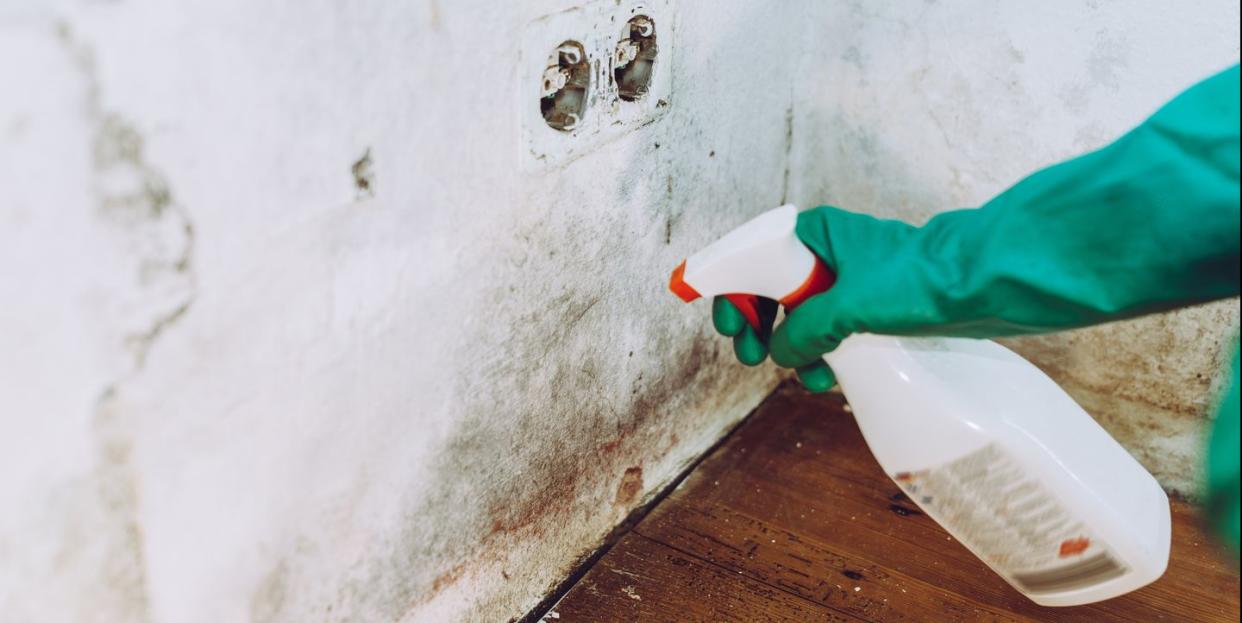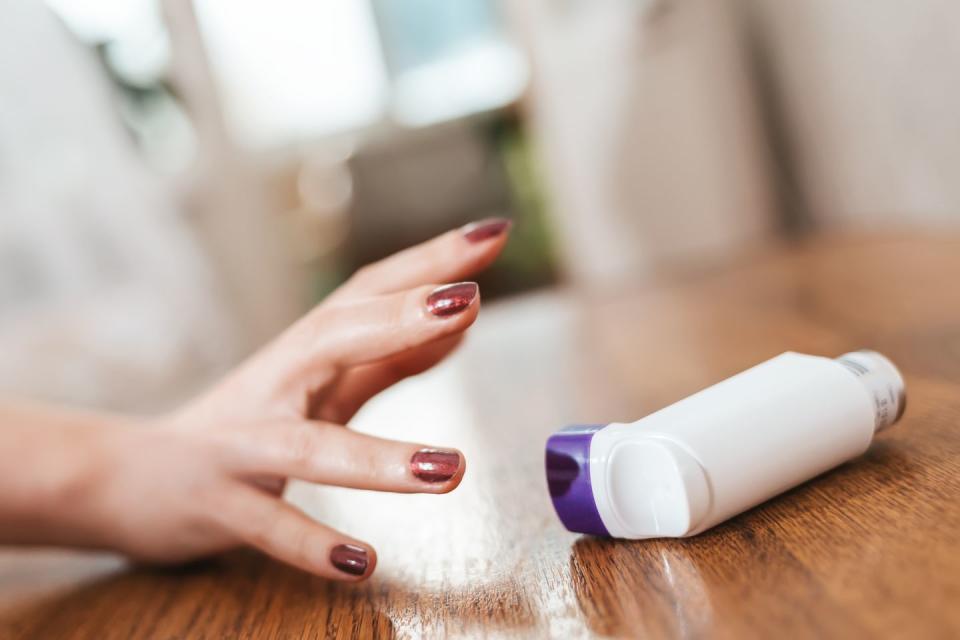How to get rid of (and prevent) mould in your home – because yes, it can cause serious health issues

When you think about mould, you might reminisce back to your murky university house that featured unattractive black speckled ceilings in your bedroom and bathroom – which btw you were *probably* paying far too much rent for. Maybe you don’t think about it at all. But take our word on this one, mould (and in particular black mould?) is not something to be overlooked, especially during the winter months.
Recent news reports have highlighted this as an issue to be aware of, with the family of two-year-old Awaab Ishak, who died in 2020 from a respiratory condition caused by mould in the flat that he called home, speaking out about the risks (and dangers of poor housing conditions). Now, with the weather taking a cold turn and the cost of living forcing people to resist turning on their radiators, mouldy homes will be much worse this year – and sadly, causing some *serious* health problems.
Last year, Shelter, the housing and homeless charity, found that the health of one in five renters were being harmed by poor housing, with damp and mould affecting 26% of all renters.
In case you were unsure of what mould actually is, it’s a type of fungus that grows in damp places. You might recognise it as fuzzy black, white or green patches on the walls, ceilings or tiles. It might smell damp and musty. Erika Radford, Head of Health Advice at Asthma + Lung UK told Cosmopolitan UK that it’s a major trigger for asthma attacks. It can also worsen symptoms for those with other lung conditions, leaving them fighting for breath. Babies, small children, older people and people with allergies are more likely to be affected.
Here’s everything you need to know about preventing mould in your house, in simple terms...
How does mould affect your health?
Eye infections, throat irritations, coughing, wheezing and shortness of breath are just a few health issues to look out for. “Mould is bad for anyone’s health, whether they have a lung condition or not, and it can in extreme cases, be life-threatening,” Radford explains.
“Exposure to mould and damp can be very harmful to our lungs, as mould releases spores that can be breathed in, causing symptoms like coughing and wheezing as well as sneezing or watery eyes.”
Radford also explains how poor housing and asthma are linked, especially as temperatures drop. “Mould in houses is worse when temperatures drop in the winter, and cold and flu viruses, which cause respiratory infections, can also thrive in colder temperatures and poorly ventilated, damp environments.
“If someone with asthma is concerned about their breathing for any reason, including exposure to mould, we would advise them to use their reliever inhaler, and to make an urgent appointment with their GP or asthma nurse. If they are having an asthma attack and their reliever isn’t making a difference, they should call 999.”

What is causing mould to appear?
Many people will be turning off their heating this winter to cope with soaring energy bills and the cost of living crisis. But, worryingly, this could be detrimental to our health because of the way mould thrives in cold and damp conditions – making this dilemma faced by plenty of us feel like a real double edged sword.
One of the causes of mould is condensation, which occurs when excess moist air hits a cold surface. The problems start when the indoor temperature drops because of the weather and lack of heating, and chances are you won’t be opening windows because you’ll want to keep as much heat in.
Kitchens and bathrooms are the most common rooms to fall victim to mould. Think about covering pans while cooking, using extractor fans, and opening windows after showering. But, whilst it would be a dream to have a bathroom window with Victorian features to admire, some UK homes don’t have a bathroom window at all. Likewise, it’s unrealistic to ask someone to dry their clothing outside when they don’t have a garden, so we’ve sussed out other potential remedies to get rid of mould below.
For more advice if you’re struggling with your living situation, consider visiting Shelter’s damp and mould in rented homes page.
How to get rid of mould on walls?
When removing mould, make sure you wear protective goggles, rubber gloves and a face mask – it’s not a glamorous job, so it’s important to do all you can to avoid exposing yourself to mould spores in the air. You should have a window open if possible to allow ventilation while cleaning.
PlumbNation, Suppliers of Plumbing and Heating products in the UK, has offered four “cheap” methods to Cosmopolitan on how to get rid of mould once and for all. (If you want to know how to *prevent* mould, skip to the next section below).
White vinegar – for heavily mouldy areas
According to the pros, mild white vinegar is a “brilliant mould deterrent” for "stubborn spores". They say: “Its acidity makes it inhospitable for mould to grow, and vinegar can clean up to 82 percent of mould species.”
Simply spray the vinegar solution onto the affected areas and wipe the surface with warm water after an hour. Dry the surface thoroughly with a towel to prevent any mould regrowth. Keep a bottle of vinegar handy in the bathroom and spray onto mould-prone surfaces every few days. Vinegar ensures that mould will never grow again on the applied surfaces.
White vinegar can be picked up for as little as 29p from local supermarkets, such as Sainsbury’s and Asda.
Baking soda
Another cheap cleaning agent to remove mould is baking soda, say the experts.
They advised using one teaspoon of liquid soap, one cup of baking soda and enough water to form a paste. Then apply the paste to the affected areas and leave for an hour before wiping it away.
Hydrogen peroxide
If all else fails, the experts advise using hydrogen peroxide. They said: “Hydrogen peroxide is available in various degrees of strength from DIY stores. For cleaning mould, it’s best to use a fairly mild three percent hydrogen peroxide solution and to dispense it into a dark spray bottle.
“If exposed to direct sunlight, the hydrogen peroxide solution will lose its chemical strength.” If this happens it will not be able to effectively get rid of mould.
The pros added: “Spray the solution directly onto the affected areas and leave for two to three hours. During this time, keep the room ventilated (open windows, turn the extractor fan on etc.) to dilute the smell of hydrogen peroxide. Once finished, wipe the surfaces clean.”
How to get mould out of fabric?
Mould can find its way onto clothes if they are stored in damp conditions – even forgetting to take your clothes out of the wash or leaving wet towels lurking in a heap at the bottom of the laundry basket can form mould. If this is the case for you, you’ll be glad to know it’s fairly simple to remove, and luckily you can use the same white vinegar and Hydrogen peroxide mentioned above.
Just make sure you check garment care labels before getting happy with the solutions.
Using white distilled vinegar
Diluted vinegar can be worked directly into the stain – or you can pre-soak the clothing in a bucket of water mixed with one cup of vinegar. You can also add 1-2 cups of vinegar to your washing machine per cycle to kill any mildew odours and brighten your whites.
Using Hydrogen Peroxide
Mix hydrogen peroxide with four parts water to create a solution. According to Persil, this should only be used on organic fabrics such as cotton and linen, as they aren’t flame-resistant.
How to prevent mould and how to protect yourself from mould?
Whether you’ve managed to get rid of the mould lurking in your home (and want it to stay that way), or you just want to protect your home as much as you can, here’s some tips from Asthma + Lung UK.
Regularly open windows and doors so air can move around.
Try to avoid drying clothes indoors. If you have nowhere else to dry them, open a window if you can.
Use extractor fans in the kitchen and bathroom or open a window when cooking or after a shower. If you have a window in your bathroom, close the bathroom door and leave the window open to prevent moisture from moving around the property.
Close the door of the room you’re in if you’re cooking or showering to prevent condensation in other rooms
Consider opening your windows for 10 minutes when you wake up. This gets some air flow into the house while also allowing the rest of the day for the house to warm back up again.
Try to keep your home at a good background temperature so it never gets too cold – it is advised all rooms are at least 15 degrees.
For more information, advice and support, you can call the Asthma + Lung UK helpline on 0300 222 5800, Monday-Friday, 9am-5pm
You Might Also Like

